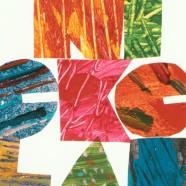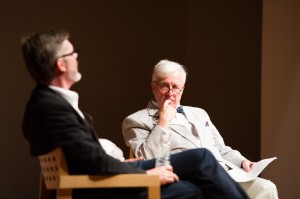
Four wide, welcoming murals — eight feet by 16 — warm the airy central hall of The Eric Carle Museum of Picture Book Art. The textured swaths of red, green, blue, yellow, are stunning tone setters — contemporary collages, you think. But then each painting tugs at a deep-seated visual memory — something familiar, nostalgic — stemming from hundreds of turns with The Very Hungry Caterpillar. The murals showcase Eric Carle’s signature tissue-paper technique writ large. Blurring the lines between fine art and illustration art is the goal of The Carle Museum. Achieving that goal is the responsibility of Nick Clark ’65, founding director, and now chief curator, of The Carle. The museum is the first in the country to feature children’s-book illustration seriously and comprehensively.
During a trip to Japan in the early 1980s, award-winning picture-book artist Eric Carle, and his wife, Barbara, learned that more than 20 museums in that country are dedicated to the art of children’s-book illustration. The Carles decided to establish just one — the first — in the United States. The architectural benchmark became, “What do we need to accommodate three school buses full of children a day?” The Carle, located in Amherst, Massachusetts, is 43,000 square feet — home to three galleries, an auditorium, an art studio, and a reading library.
Eric Carle had connected with Nick informally in the past, and he decided that Nick was the right person to bring the museum’s programmatic vision to life. Nick studied art history at Harvard, earned his Ph.D. at the University of Delaware, and had devoted many years to educating people about art. He was both prepared and enthusiastic about honoring the art of picture-book illustration, and creating a welcoming environment for children, and for adults.
 “I could take an illustration by Maurice Sendak and connect it to Albrecht Dürer or Winslow Homer,” Nick says. “Eric understood that I saw illustration in an art historical context.” At the outset, Nick wanted to honor the “titans of the trade” — Leo Lionni, Virginia Lee Burton, Mitsumasa Anno. The Carle, which opened its doors in 2002, has mounted more than 100 exhibitions, including thematic and group exhibitions. It has showcased favorite artists, including E. H. Shepard, Nancy Ekholm Burkert, Dr. Seuss, Chris Van Allsburg and Mo Willems. “We use that which is familiar to prove that appreciating art doesn’t have to be intimidating,” Nick says.
“I could take an illustration by Maurice Sendak and connect it to Albrecht Dürer or Winslow Homer,” Nick says. “Eric understood that I saw illustration in an art historical context.” At the outset, Nick wanted to honor the “titans of the trade” — Leo Lionni, Virginia Lee Burton, Mitsumasa Anno. The Carle, which opened its doors in 2002, has mounted more than 100 exhibitions, including thematic and group exhibitions. It has showcased favorite artists, including E. H. Shepard, Nancy Ekholm Burkert, Dr. Seuss, Chris Van Allsburg and Mo Willems. “We use that which is familiar to prove that appreciating art doesn’t have to be intimidating,” Nick says.
The Carle’s expansive art studio is a distinguishing feature, available to visitors of all ages, whenever the museum is open. Everything is hands-on, eyes-on, ears-on at The Carle, which relies minimally on technology. The building is wired and prepared to “boot up” as needed, but families typically appreciate the refuge.
Well before The Carle’s inception, Nick was a devotee of picture-book art. In 1996, he and his late wife, Trinkett, with fellow curator Michael Patrick Hearn, launched an exhibition of American children’s-book illustration at the Chrysler Museum in Norfolk, Virginia, where Nick was curator of American art. The exhibition was bold, bucking the disparaging attitude toward children’s literature and illustration art at the time. “Guests entered that exhibition with a very different attitude,” says Nick. “They were coming to see friends. If you give people a way to relate, they will embrace the opportunity in a very meaningful way.”
Before his curatorial days, Nick taught art history at Exeter, and he was shocked that his very bright students were essentially visually illiterate. They didn’t understand that decoding a visual image was comparable to decoding a written text. “We all see things differently,” he told his students. “If you have a good reason for what you see, your point of view is valid.” The conversation becomes increasingly sophisticated, Nick explains, but at the outset, you just want people sharing.
In the late ’90s, Nick learned about Visual Thinking Strategies (VTS), an approach in museum education. The learner-centered method of examining and finding meaning in visual art relies on three open-ended questions: What’s going on in this work of art? What do you see that makes you say that? What more do you see?
“The parallels between visual and verbal learning are potent,” says Nick. “This open-ended approach requires good listening, good paraphrasing, and — most importantly — suspending judgment. If you’re part of the conversation, you validate even the most elementary or awkward observation, because it’s about the conversation. We want the novice to feel comfortable talking about a work of art.”
Around the world, every museum exhibition tells a story — about a person, a culture, a moment in time. The Carle’s recent exhibition was a visual biography of Bernard Waber (Lyle, Lyle, Crocodile) through his books. The artist never gave up his day job. He would come home from an eight-hour day in the office and set to work on his books. “We wanted people to understand that about him,” says Nick. “Waber created a book called A Firefly Named Torchy; the artwork is abstract expressionist, like a Jackson Pollock painting. That’s because the Time Life offices, where Waber worked, were around the corner from the Museum of Modern Art, and he had a press pass.
“We’re trying to tell the story of the artist, but by showing people Torchy, and then looking at Jackson Pollock, we’re also elevating the status of illustration art. In another of Waber’s books, a couple looks out a window from the façade of a building — a visual riff on Grant Wood’s American Gothic. These illustration artists have immense visual libraries they bring into play.”
Why do some children’s books endure, becoming treasures for generations of readers? Peter Rabbit, Goodnight Moon, Mike Mulligan and His Steam Shovel, Make Way for Ducklings, Where the Wild Things Are.
“These stories share profound and sophisticated messages, couched in extraordinarily engaging and accessible ways,” says Nick. “The Very Hungry Caterpillar teaches numbers and days of the week, but it’s a story about growing, and transformation. The story helps a boy or girl going off to school know that he or she is going to be OK. Many of the most enduring and powerful stories come to a child through the lenses or voices of humble animals, so children find them manageable. Finally, these books engage the parents as well as the child.”
Nick fondly recalls reading Esphyr Slobodkina’s Caps for Sale to his daughter when she was 18 months old. (Slobodkina’s illustrations were in the spirit of French painter Henri “leDouanier” Rousseau — flat and simple shapes.) “I hammed it up, which I love to do,” says Nick,“and when we finished, she looked at me and said, ‘Again.’ My daughter is 29 now, and we still read that book together once a year.”
— by Erin Berg
Twenty Books Nick Clark Says You Must Read to a Child You Love
Peter Rabbit by Beatrix Potter
Millions of Cats by Wanda Gág
The Story of Ferdinand by Munro Leaf
Madeline by Ludwig Bemelmans
Pat the Bunny by Dorothy Kunhardt
Curious George by H. A. and Margret Rey
Swimmy by Leo Lionni
Sylvester and the Magic Pebble by William Steig
Make Way for Ducklings by Robert McCloskey
Charlotte’s Web by E. B. White
Harold and the Purple Crayon by Crockett Johnson
Eloise by Kay Thompson
The Cat in the Hat by Dr. Seuss
The Velveteen Rabbit by Margery Williams
The Snowy Day by Ezra Jack Keats
Where the Wild Things Are by Maurice Sendak
Frog and Toad by Arnold Lobel
Snow White by Nancy Ekholm Burkert
George and Martha by James Marshall
Jumanji by Chris Van Allsburg




